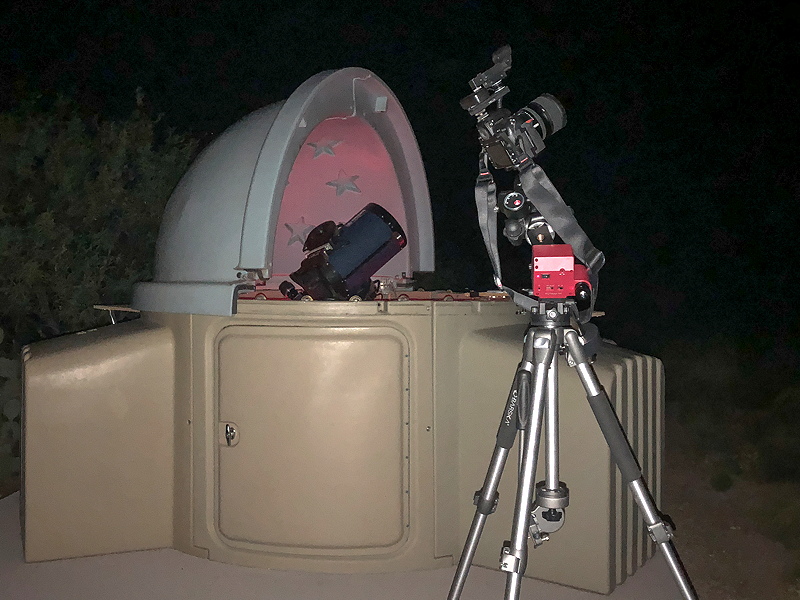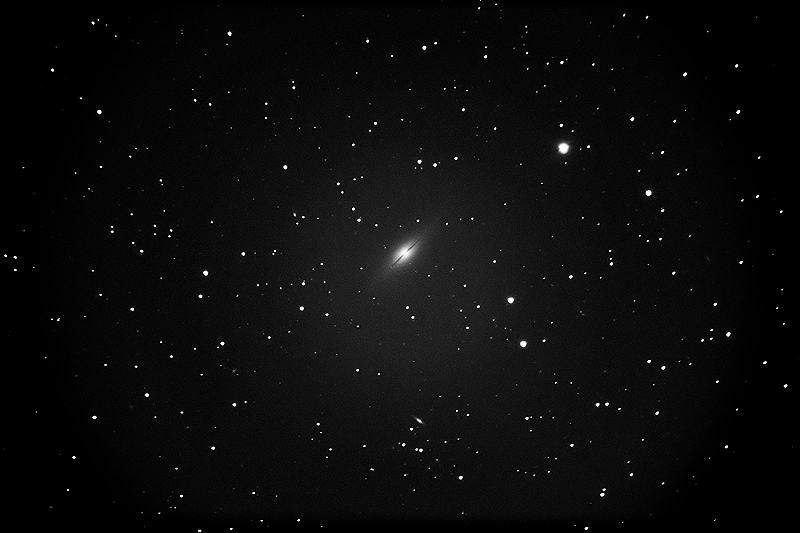SkyTracker Pro iPhone & DSLR Sky Astrophotography;
NGC7814 Galaxy
Posted: 6 October 2018
|
Open: Friday, 5 October 2018, 1808 MST Temperature: 86°F |
Session: 1287 Conditions: Clear |
Equipment Used:
12" f/8 LX600 w/StarLock
2" 24mm UWA eyepiece
SkyTracker Pro
Camera:
iPhone 8 Plus
D850 DSLR
I set up the SkyTracker Pro with the iPhone 8 Plus on the observatory patio.

1823 MST: LX600 ON, StarLock OFF, High Precision OFF.
1825 MST: took quick looks at some planets, 102X. Venus was a nice colorful (due to atmospheric refraction) crescent. Jupiter showed its four Galilean Moons. Saturn had two moons currently visible. Mars with its South Polar Cap and a dark surface area were a nice view.
I then prepared the D850 DSLR for later sky astrophotography.
1840 MST: slewed to M31 (Andromeda Galaxy). Not yet visible against the still bright twilight sky.
1852 MST: High Precision ON.
Reslewed to the Andromeda Galaxy. M31 and its companion galaxy M32 were now visible, 102X.
1854 MST: High Precision OFF.
Next, I polar aligned the SkyTracker Pro.
1925 MST: remounted the iPhone on the SkyTracker Pro using the Levenhuk Smartphone Adapter. Rechecked the polar alignment.
Took this tracked iPhone sky photo showing the constellation of Cassiopeia at the upper left and the constellation of Andromeda through the middle using NightCap Camera (Long Exposure, Light Boost, ISO 8448, 1/3sec, 1 minute). The Andromeda Galaxy and the Double Cluster (open star clusters) are also visible in the photo.

Mouseover or tap on image for labels
I switched to the iPhone 8 Plus 2X telephoto lens for this tracked photo with NightCap Camera (Long Exposure, Light Boost, ISO 8448, 1/3sec, 5 minutes) showing the constellation of Andromeda and the Andromeda Galaxy.

1946 MST: ended iPhone sky astrophotography.
Mounted the D850 DSLR with the ScopeStuff Red Dot Finder on the SkyTracker Pro.

This is a tracked sky photo, f/2.8, 1 minute, ISO 6400, White Balance 4000K, FL 24mm, showing the Andromeda Galaxy (M31) at the center, with the Triangulum Galaxy (M33) below M31, the Double Cluster at the left, and a portion of the Milky Way along the left side. Some green airglow is also visible in the photo.

Mouseover or tap on image for labels
This is a cropped image of another tracked sky photo, f/2.8, 2 minutes, ISO 6400, White Balance 4000K, FL 24mm, showing the Andromeda Galaxy (M31), the Triangulum Galaxy (M33), and the Double Cluster.

Mouseover or tap on image for labels
2028 MST: ended sky astrophotography.
2035 MST: viewed M31, M32, and M110 galaxies, 102X. I then viewed NGC7814 (galaxy), 102X.
Mounted the D850 DSLR at prime focus of the 12" telescope to image NGC7814 for my Extragalactic Supernova Project.
2041 MST: High Precision ON.
Focused and locked the LX600 mirror.
2046 MST: StarLock ON.
This is a StarLock autoguided, 5 minutes, ISO 6400, White Balance 5000K, image of NGC7814 (galaxy).

2052 MST: StarLock OFF, High Precision OFF.
2103 MST: LX600 OFF.
|
Close: Friday, 5 October 2018, 2114 MST Temperature: 61°F |
Session Length: 3h 06m Conditions: Clear |
Comments are welcome using Email. Twitter users can use the button below to tweet this report to their followers. Thanks.
Cassiopeia Observatory Home Page
Copyright ©2018 Michael L. Weasner / mweasner@me.com
URL = http://www.weasner.com/co/Reports/2018/10/06/index.html
